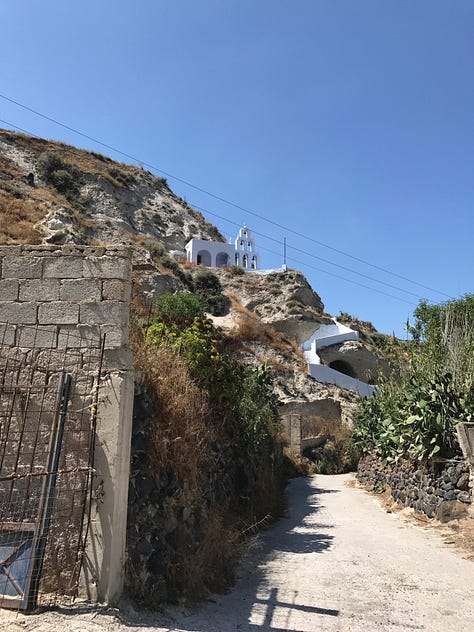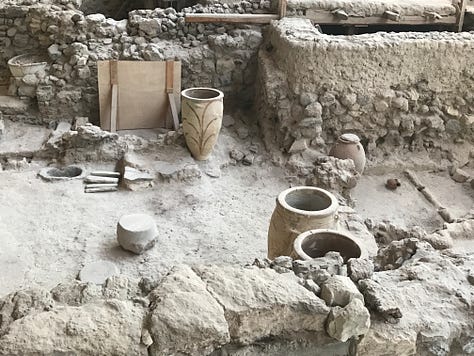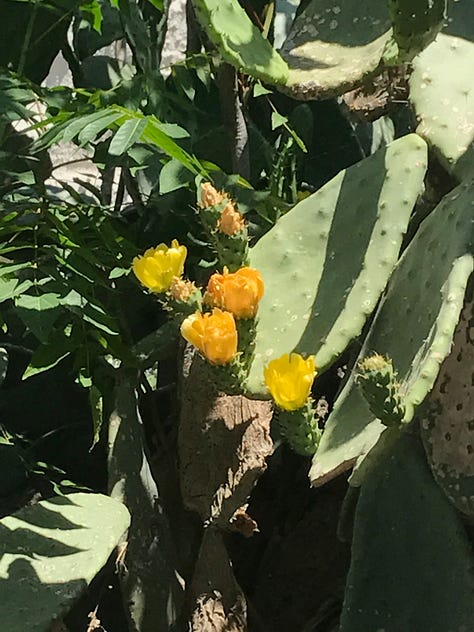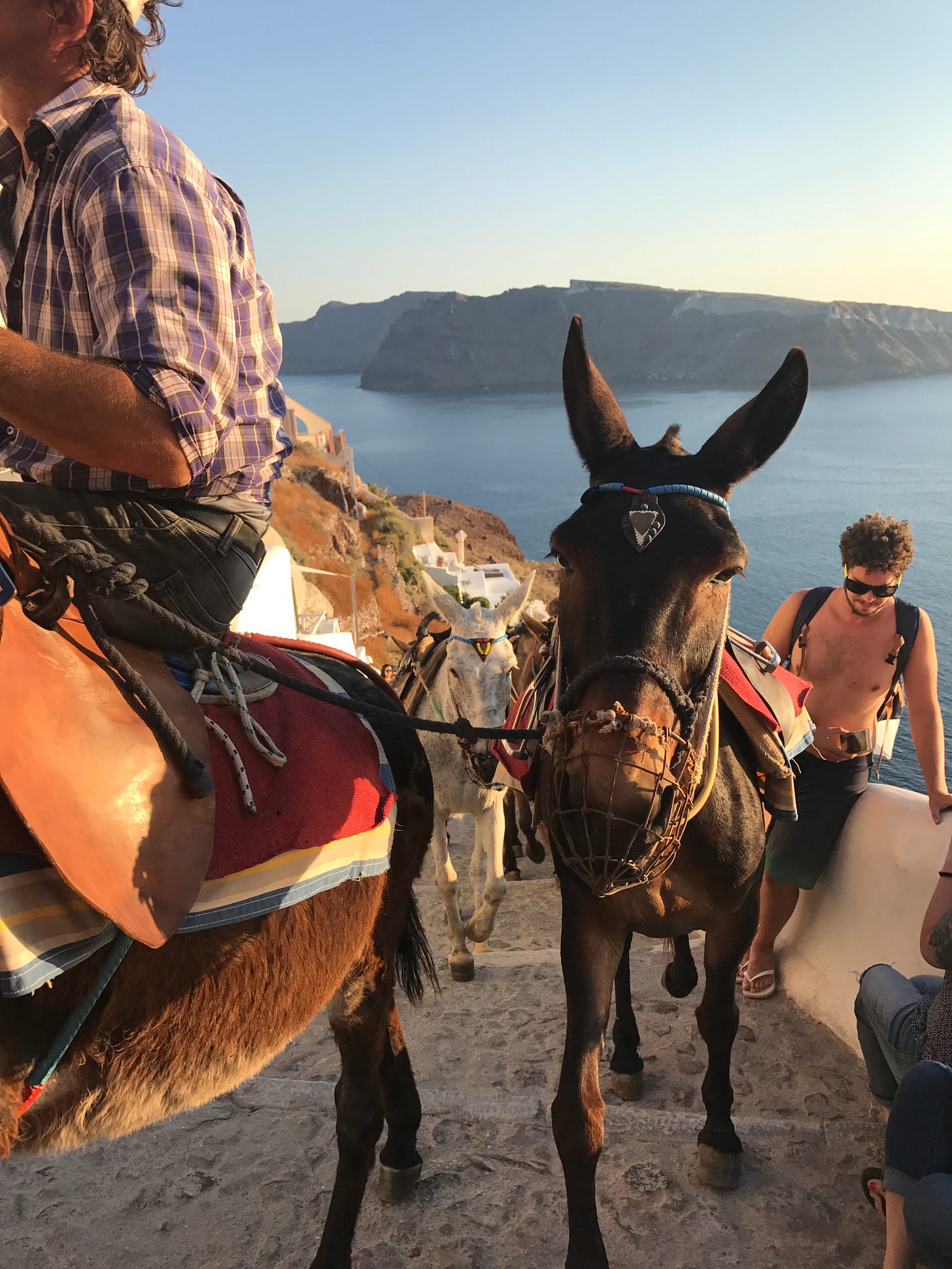On the Greek island of Santorini, a donkey track leads from the coastline where small ships dock, up the cliffs, to the village of Fira at the top. The donkeys must climb hundreds of steps, and so must you, carefully stepping around fresh signs of a donkey to reach the clifftop. Originally, the donkeys carried supplies off boats and up the steep cliffs to the villages above, but today, tourists can hire them to be carried up the steps, although this has become controversial, so often, the donkeys are merely paraded through the narrow passages of the village, a pastiche to their historical purpose. High above the port, tourist shops, restaurants, and hotels line the caldera, and the donkeys pick their way between the buildings and tourists, their tiny bells tinkling with each metal-shod step.
In May, the weather makes Santorini a provocative woman. Some days wrapped in cool, cloudy mystery, hiding her curves, hills and islands, even the sea. Some days, bright, warm, so open and blindingly revealing that you turn away as she spreads her curves before you –curve of earth, mound of mountains, valley of grape vines and fig trees. Her sinuous winding roads, calm blue sea, and striking sun, icy cold and blazing hot. Some days she is both, from one minute to the next. Just like me. I have come to Santorini to rest and recover after a major surgery, a surgery that left me a woman, but not a woman, to find myself again, or to meet my new self.
And on Santorini, the donkeys, well fed, beautifully adorned, bells jingling, braying or not, set me on a quest I did not expect.
On most days, cruise ships anchor offshore, and tiny boats ferry up to 4,500 passengers daily to the island. The passengers then take the cable car, hire a donkey, or laboriously climb the 588 steps to the top of the mountain, then shop at the stores, buy leather goods, trinkets, jewelry, and maybe an ice cream. They eat at the tourist spots and explore the few blocks off the main market area. A couple of hours later, they head back down the donkey track, board the little boats and sail away.
They have missed everything off the donkey track. Santorini has a town on top of a hill that was destroyed by volcanic ash, like Pompei. This town, Akrotiri, was a thriving metropolis, complete with running hot and cold water and flushing toilets 3,600 years ago. You can see stores of grain left behind in large pottery vases, encased in ash. Some of Greece's most beautiful frescoes and mosaics were found in the buried palaces of Akrotiri.
The tourists have missed the olive groves, the bottlebrush blooming, the medieval town of Pyrgos Kallistis that sleeps in the day while its residents are off at work, the black sand beach of Kamari, swimming in the sea with pockets of heat from vents from the volcano that lies sleeping and partially submerged by the caldera.
These tourists have missed Nona’s famous frosted orange cake found at a café at the end of Kamari Beach near the ancient orthodox church that has stood for centuries in the shadow of the cliffs, or the grocery store in Eborio where you can buy a lemon juicer for a euro (and which has accompanied most of my travels along with my miniature coffee press since), and all the points in between.
They have missed the fact that not only can you watch the sunset from the town of Oia with its famous blue and white barrel-shaped rooftops, but that you can also witness the sun rise over this island, and observe an entire day pass before you, a perfect example of how Earth sees time, not in increments of a ticking clock, but in the rounding of the sun.
In Santorini, I learned that time has no meaning except for the intersection of two or more people at a particular place. I didn’t know the word spacetime then, or the meaning of measurement in quantum physics, but Santorini taught me by experience. Greece is, after all, the place where Democritus, about 2,400 years ago, first described matter as made up of particles and used the word “atom.” There must be something in the water here.
Santorini also made me think about how it’s easy for all of us to live only on the donkey track—a place where we can see and do a lot, but where we are a tourist entertained, not an explorer, and where we are only looking at a showcase, the outside, the edge of what really is. When we venture outside this comfort zone or what is easy, we find that another world exists just beyond what is served up for our entertainment. And in that place beyond the donkey track, we learn, discover, and find things that interest us, teach us, and move us.
So this blog will be a place where I explore thoughts and experiences from just off the donkey track, whether it be a place from my travels, bike rides, or walks, or whether it be an encounter with our fellow sojourners on this earth—animal, vegetable or mineral—that give me pause for thought and reflection, that lift me up, turn my mind, instruct me. And I hope that you will join me on this journey just beyond the beaten path.


















I love your description of Santorini as a provocative woman! 👏👏
I really enjoyed reading this!